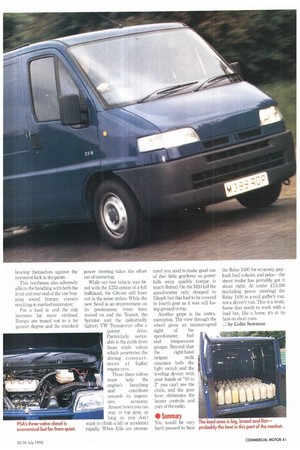MROEN REP 10 SWE
Page 42

Page 43

If you've noticed an error in this article please click here to report it so we can fix it.
Price as tested: El 3,988 (ex-VAT). Includes 213,340 for base model; £415 for central locking and electric windows; and 2233 for full-height glazed bulkhead.
Engine: 2.5 litre IDI diesel, 84hp (63kW). GVW: 3,250kg. Payload: 1,480kg. Fuel consumption (laden): 28.8 mpg (9.814/100km).
The new Sevel range, as with other panel vans, is characterised by a modular build system: you take three engines, three wheelbases and three payloads, add a couple of roof heights and hey presto, you've got a van range. Then it's simply a case of asking the customers what they want and piecing together the modules to construct the right van.
By this means you can get the Citroen-badged Sevel van with payloads between 1.1 and 1.6 tonnes on wheelbases between 2.8 and 3.7m with engines
between 68 and 102hp (51 -76kW). Ask the typical street
trader who runs a van what they want and chances are many will say the biggest payload on the shortest wheelbase. Many will not invest in racking and every thing is loaded onto the floor so there's no point going for a high roof. As to the engine, well we want a bit of power but the turbo is an added complication, so go in the middle.
By this tortuous route you will end up with a short-wheelbase Relay 1400 with standard roof and the non-turbo 2.5-litre diesel engine. As a measure of how many buyers have done this calculation, this vehicle is the second largest seller in the range (after the base level Relay 1000). To find out if the buyers have got it right we put an example through its paces.
In short-wheelbase guise the Relay 1400 gets the 2.5-litre naturally-aspirated PSA unit with indirect-injection and three valves per cylinder. This pushes out a respectable 84hp (63kW) at 4,3 5Orpm, with torque figures of 1131bft (153kW) at 2,250rpm. The stubby, dash-mounted gearlever controls a new five-speed synchromesh gearbox which has a top ratio of L39:1—even fourth is over 1:1. The ease of entry and ample storage makes it well suited to multi-drop work.
• Productivity
There's no denying the class-leading loadspace afforded by the Sevel; frontwheel drive allows it to have the lowest unladen floor height (540mm) of the one
tonne-plus panel vans. This is the proverbial box on wheels: you can't get one with under 7.5m3 of payload volume (6.5m3 using the stricter VDA measurement). The doors are also big: the side door is wider than those in the Transit or Sprinter and full height too, even with the high roof. The rear opening is a whisker larger than the Sprinter and has an inch on the Transit. Payload is also impressive at around 1.4 tonnes on a wheelbase of 2.&5m and still gives a load tolerance of 150kg.
Around our Kent light van route the fully laden Relay turned in an class-leading 28.8mpg (9.8 lit/100km). The most comparable vehicle is the Transit 150 SWB tested in June 1993 which had laden consumption figures of 27mpg (10.4 lit/100km). Where the Citroen did lose out was speed. It completed the route at an average speed of 60.7Iunh (37.8mph), which is 7km/h (4.5 mph) slower than the Transit. While traffic conditions are the limiting factor on this route, the Relay is not a sparkling performer and has to work quite hard on motorways.
• On the road
The flip side of the Relay's short wheelbase and impressive payload is that driving it empty is painful.
It can only be compared with driving a steel-suspended, uncoupled tractive unit. Towards the end of longer unladen runs drivers will find themselves looking for bumps on the motorway and bracing themselves against the imminent kick in the pants.
This harshness also adversely affects the handling with both the front and rear end of the van hopping round bumpy corners resulting in marked understeer.
Put a load in and the ride becomes far more civilised. Bumps are ironed out to a far greater degree and the standard power steering take.; the effort out of cornering.
While our test vehicle was fitted with the 033 option of a full bulkhead, the Citroen still loses out in the noise stakes. While the new Sevel is an improvement on its predecessor, times have moved on and the Transit, the Sprinter and the (admittedly lighter) VW Transporter offer a quieter drive. Particularly noticeable is the rattle from those triple valves which penetrates the driving compartment at higher engine revs.
Those three valves must help the engine's breathing and contribute towards its impres sive economy. Around town you can stay in top gear, as long as you don't want to climb a hill or accelerate rapidly. When hills are encoun tered you need to make good use of that little gearlever as power falls away quickly (torque is much flatter). On the M20 hill the speedometer only dropped to 52mph but this had to be covered in fourth gear as it was still losing ground in top.
Another gripe is the instrumentation. The view through the wheel gives an uninterrupted sight of the speedometer, fuel
and temperature gauges. Beyond that
the right-hand (wiper) stalk obscures both the light switch and the leveling device: with your hands at "10 to 2" you can't see the clock, and the gear lever obliterates the heater controls and part of the radio.
• Summary You would be very hard pressed to beat the Relay 1400 for economy, payload, load volume, and price—the street trader has probably got it about right. At under £13,400 (including power steering) the Relay 1400 is a real gaffer's van, not a driver's van. This is a workhorse that needs to work with a load but, like a horse, it's at its best on short runs.
—I by Colin Sowman




























































































